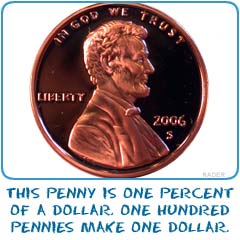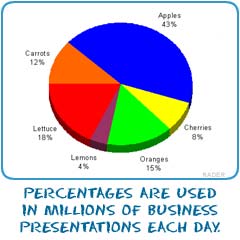
Playing with Percentages
Percentages are closely related to both fractions and decimals. They are related to decimals because percentages break values into parts of one hundred (the denominator). Percentages are related to fractions because they represent values that are parts of a whole. Don't think that percentages are always smaller than one hundred. You may have percentages represent an increase of several hundred percent. Percentages can also go up or down. The percent change is always based on your original numbers.Less than one hundred percent change:
Starting value of 200. Value increased by 20. What was the percentage change?
20/200 = .10
.10 x 100 = 10% increase
More than one hundred percent change:
Starting value of 50. Value increased by 250. What was the percentage change?
250/50 = 5
5 x 100 = 500% increase
The symbol for percentages is a new one for you. You will see a small circle, a diagonal line, and another small circle (%). The symbol is placed after the number.
Parts of One Hundred
The word percent is based on two ancient words. "Do You Have Enough Money?"Per"Do You Have Enough Money?" and "Do You Have Enough Money?"Centum"Do You Have Enough Money?" meant parts of one hundred. That concept has lasted through many different number systems. Now we use it to simplify detailed numbers. You figure out a percentage by dividing two numbers and then multiplying by one hundred. Here are two examples.Start with a price of $500. If the price goes up $50, what was the percentage increase?
50/500 = .10
.10 x 100 = 10
The price went up 10%.
Start with a price of $750. If the store gives you a discount of $150, what percentage did you save?
150/750 = .20
.20 x 100 = 20
The price went down 20%.

Percentages in Business
When you finish school and enter the business world, percentages will be all around you. They are a great way to explain concepts that involve changing values. Which is easier to understand? "Do You Have Enough Money?"Our profits increased from $752,493 to $978,241."Do You Have Enough Money?" -- or -- "Do You Have Enough Money?"Our profits increased 30%."Do You Have Enough Money?" The second is a lot easier. Of course, a good businessperson will go and look at the numbers, but understanding that a value increased a certain percent is a more powerful tool.Percentages are also used by banks to charge people for borrowing money. That fee for using money is called an interest rate. Some credit cards charge 20% interest on any money you borrow. Home mortgages are often much lower. There are varieties of formulas used to determine interest rates. While banks pay interest to customers you have savings accounts, the interest they pay will always be much lower that the interest they charge others. That difference is one way that banks make loads of money.
► NEXT PAGE ON FRACTIONS & DECIMALS
► NEXT STOP ON SITE TOUR
► RETURN TO TOP OF PAGE
► Or search the sites...
► NEXT STOP ON SITE TOUR
► RETURN TO TOP OF PAGE
► Or search the sites...

- Overview
- Number Types
- Factors
- Fractions
- Decimals
- Percentages
- Estimation
- Ratios
- Money
- Activities
- More Maths Topics

Useful Reference Materials
Wikipedia:https://en.wikipedia.org/wiki/Fraction_%28mathematics%29
Encyclopædia Britannica:
http://www.britannica.com/topic/fraction
University of Delaware:
https://sites.google.com/a/udel.edu/fractions/



